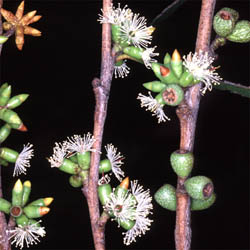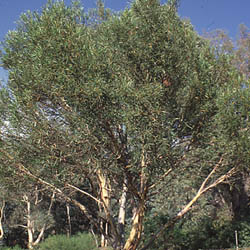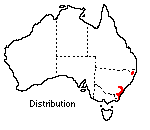Eucalyptus moorei
 |
 |
 |
Narrow-leaved Sally, or Little Sally
Eucalyptus moorei Maiden & Cambage
Eucalyptus moorei, commonly known as Narrow-leaved Sally, or Little Sally, is native to moderately high country in New South Wales, and is therefore well suited to Canberra's similar climate. It grows in the Gibraltar Range in the State's north, in the Blue Mountains between 1000 m and 1200 m and at an altitude of 600 - 800 m in the Budawang Ranges north-east of Braidwood and further south in heathland. It takes the form of either a small tree, seldom over 6 m tall, or a multi-stemmed shrub (mallee), and in its natural habitat, where the soils are shallow and low in nutrients, often forms thickets. It grows on cold, wet sites suggesting tolerance of poor drainage; however, this has not been tested at the Australian National Botanic Gardens.
 Several
specimens of E. moorei growing in the Gardens have been propagated from
seed collected at Bell, 15 km north of Blackheath in the Blue Mountains. In
eight years they grew into shapely small trees, 4 m tall. The leaves are 5-6
cm long and are borne on a yellow petiole or leaf stalk. In the months before
flowering the combination of yellow petioles and dense clusters of yellow buds
causes the tree to take on an overall warm tinge. The previous season's capsules
remain along the lower branches and are an attractive feature in themselves.
Several
specimens of E. moorei growing in the Gardens have been propagated from
seed collected at Bell, 15 km north of Blackheath in the Blue Mountains. In
eight years they grew into shapely small trees, 4 m tall. The leaves are 5-6
cm long and are borne on a yellow petiole or leaf stalk. In the months before
flowering the combination of yellow petioles and dense clusters of yellow buds
causes the tree to take on an overall warm tinge. The previous season's capsules
remain along the lower branches and are an attractive feature in themselves.
Flowering time in Canberra is March - April, when masses of white flowers appear. However, individual flowers have been observed as early as January.
Narrow-leaved Sally is recommended for small gardens where a compact, shapely tree is desired. It is especially useful in that it is one of the few frost-hardy eucalypts which can be grown in a small native garden without dominating other plantings. Another small tableland species, Eucalyptus stricta, the Blue Mountains Mallee, with distribution similar to E. moorei, could well be combined with it to maintain this low canopy yet provide some variety in the garden.
Eucalyptus moorei is generally fairly free of pests and diseases, with few leaves showing signs of damage by leaf-eating insects. The presence of scale insects has been observed at times and this is the only pest affecting E. moorei that has required attention at the Gardens. Small infestations may be controlled by scrubbing affected areas with an old toothbrush dipped in soapy water or white oil. Chemical control should focus on lower toxicity products that cause less environmental damage. Contact local experts for advice.
Propagation is from seed.
Text by Tony Wilkinson, ANBG (1980)
Name meaning: Eucalyptus mooreiEucalyptus - a latinised Greek compound, eu, well,and kalyptos, veiled or covered, an allusion to the calyx and/or petals which form a lid over the flower bud; moorei - in honour of Charles Moore (1820-1905), NSW Government Botanist, 1848-96. |
![An Australian Government Initiative [logo]](/images/austgovt_brown_90px.gif)

